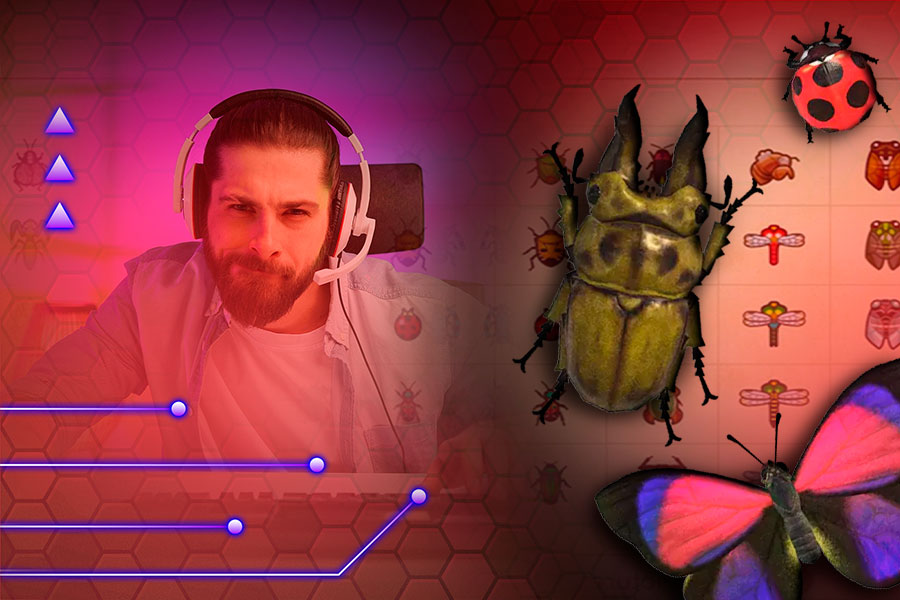

Share this content!
Share this content!
Table of contents
- Why should you catch all Animal Crossing bugs?
- How many bugs are in Animal Crossing?
- How and when catching Animal Crossing bugs?
- Common butterfly
- Yellow butterfly
- Tiger Butterfly
- Peacock Butterfly
- Common bluebottle
- Paper Kite Butterfly
- Great Purple Emperor
- Monarch Butterfly
- Emperor butterfly
- Agrias butterfly
- Rajah Brooke’s Birdwing
- Queen Alexandra’s Birdwing
- Moth
- Atlas moth
- Madagascan Sunset Moth
- Long Locust
- Migratory Locust
- Rice Grasshopper
- Grasshopper
- Cricket
- Bell cricket
- Mantis
- Orchid Mantis
- Honeybee
- Wasp
- Brown cicada
- Robust Cicada
- Cicada shell
- Red Dragonfly
- Mole Cricket
- Ladybug
- Golden Stag
- Rosalia Batesi Beetle
- Goliath Beetle
- Walking Stick
- Flea
- Centipede
- Spider
- Tarantula
- Scorpion
- What is the rarest insect in Animal Crossing?
- Did the Ugamians already catch all Animal Crossing bugs?
- Are you ready to master the Insect Kingdom in Animal Crossing?
One of the most challenging but fun things about Animal Crossing: New Horizons is to catch all bugs. So, not only do you get to create and design your own island paradise, but you also have the opportunity to discover a captivating array of bugs.
From beautiful butterflies to dangerous spiders, the diverse insect population of Animal Crossing: New Horizons is waiting to be explored and captured. This article will guide you on an exciting bug-hunting adventure, revealing great info to help you locate and catch these fascinating critters.
So grab your net (and some medicine, if possible), and let’s embark on a journey through the colorful Arthropoda world in Animal Crossing: New Horizons!
Why should you catch all Animal Crossing bugs?
Catching all the bugs in Animal Crossing: New Horizons offers several benefits and rewards for players. So, if you finished the main story but still don’t have all bugs in your Critterpedia, we highly recommend you make an effort to catch them all:
Filling your Critterpedia
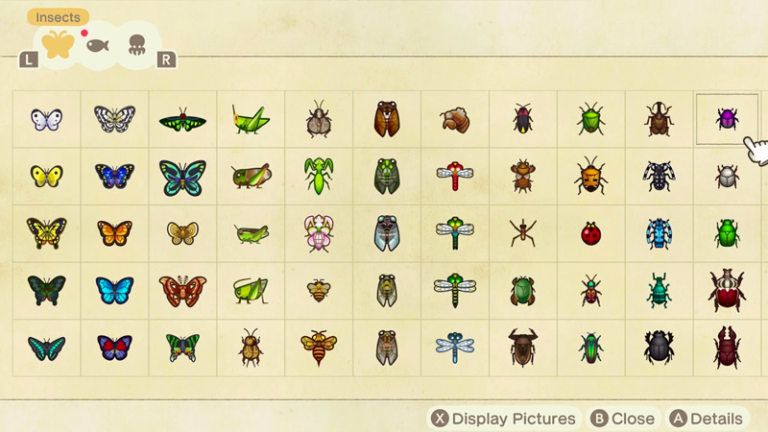
Of course, the first reason to catch all the Animal Crossing bugs is to complete your Citterpedia. Each bug you grab is recorded in your Critterpedia, acting as a personal encyclopedia of all the bugs you’ve encountered. It serves as a record of your progress and can be a source of pride.
The Critterpedia is a catalog or encyclopedia of all the fish, insects, and sea creatures you’ve encountered and caught in the game. It helps you to keep track of the different species you’ve collected.
It also includes information about the creature, like the location, season, and the time it appears.
Museum collection

By catching and donating bugs to the museum, you help complete the collection. It adds depth to the museum and provides a visually stunning display for players.
For players who enjoy completing tasks and achieving milestones, catching all the bugs becomes a personal accomplishment. It adds a sense of achievement and fulfillment to the game.
Nook Miles rewards
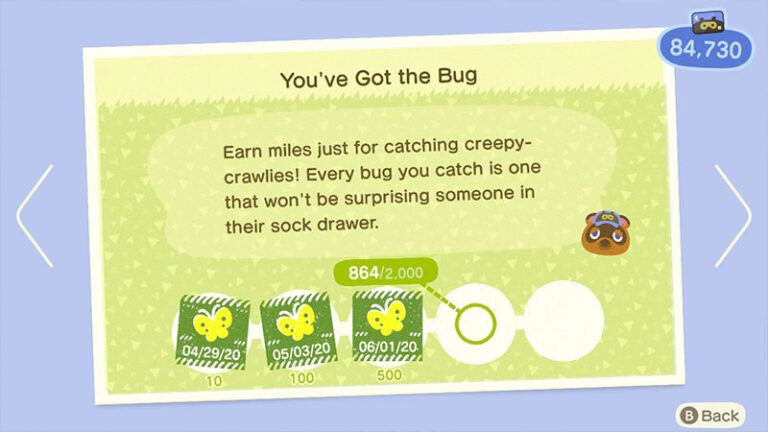
Catching bugs will help you to get Nook Miles achievements, which can be exchanged for exclusive items and rewards. These rewards can enhance your gameplay experience and provide new opportunities for customizing your island.
Fun and fortune

Bugs can be traded or gifted to other villagers. Since this promotes social interaction and collaboration, you can get something in return by doing that. Also, selling bugs can be a lucrative way to earn Bells to buy other things. Specific bugs, especially rare or seasonal ones, can fetch high prices when sold.
Relaxation
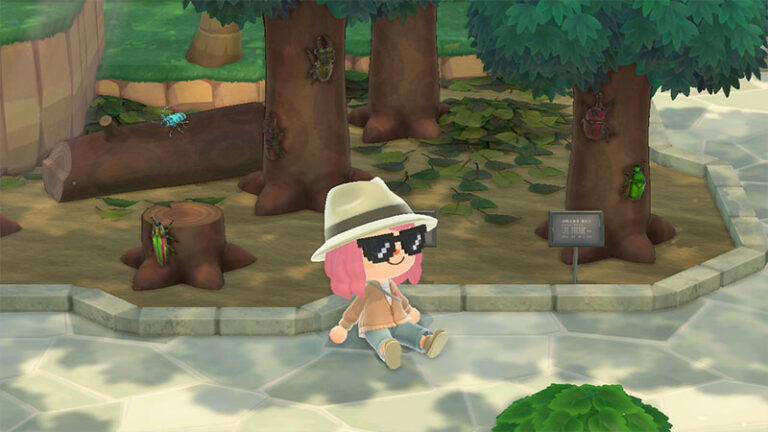
Lastly, catching Animal Crossing bugs can be a fun and relaxing activity in the game. It offers a sense of exploration and discovery as you search for new species and can serve as a pleasant pastime when you are playing. So, enjoy the process!
How many bugs are in Animal Crossing?
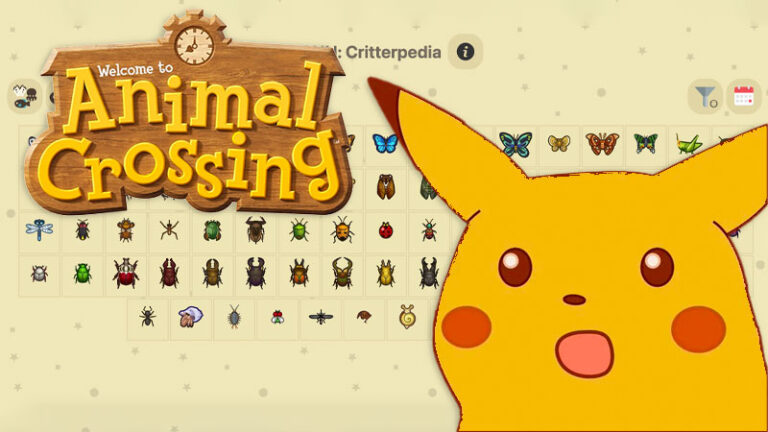
There are 80 bugs to discover and capture in Animal Crossing: New Horizons. These include cute butterflies, dangerous spiders, and noisy cicadas. Each bug presents a unique challenge and a chance to expand your Critterpedia.
How and when catching Animal Crossing bugs?
Common butterfly
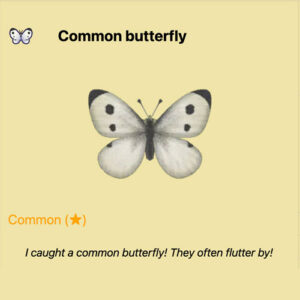
- Where to find it: Flying around the island.
- When to find it: From 4 AM to 7 PM, except when it rains. For the northern hemisphere islands, all year except in July and August. For the southern hemisphere islands, all year except in January and February.
Yellow butterfly
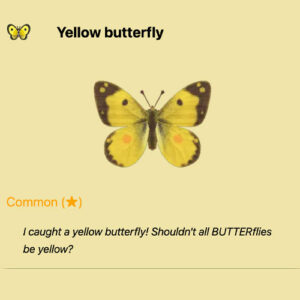
- Where to find it: Flying around the island.
- When to find it: From 4 AM to 7 PM, except when it rains. For the northern hemisphere islands, in March, April, May, June, September, and October. For the southern hemisphere islands, in March, April, September, October, November, and December.
Tiger Butterfly
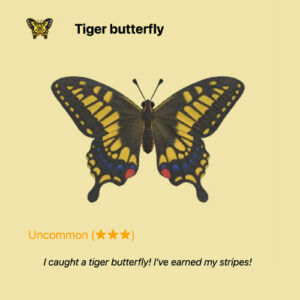
- Where to find it: Flying around the island.
- When to find it: From 4 AM to 7 PM, except when it rains. For the northern hemisphere islands, in March, April, May, June, July, August, and September. For the southern hemisphere islands, in January, February, March, September, October, November, and December.
Peacock Butterfly
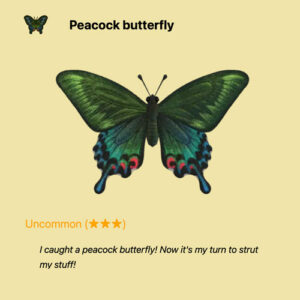
- Where to find it: Flying near blue, black, and purple flowers.
- When to find it: From 4 AM to 7 PM, except when it rains. For the northern hemisphere islands, in March, April, May, and June. For the southern hemisphere islands, in September, October, November, and December.
Common bluebottle
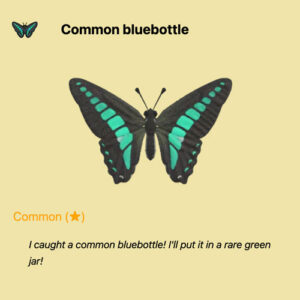
- Where to find it: Flying around the island.
- When to find it: From 4 AM to 7 PM, except when it rains. For the northern hemisphere islands, in April, May, June, July, and August. For the southern hemisphere islands, in January, February, October, November, and December.
Paper Kite Butterfly
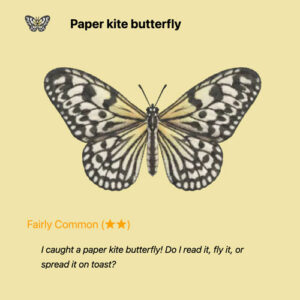
- Where to find it: Flying near blue, black, and purple flowers.
- When to find it: From 8 AM to 7 PM, except when it rains. All year for both hemispheres.
Great Purple Emperor

- Where to find it: Flying near flowers.
- When to find it: From 4 AM to 7 PM, except when it rains. For the northern hemisphere islands, in May, June, July, and August. For the southern hemisphere islands, in January, February, November, and December.
Monarch Butterfly
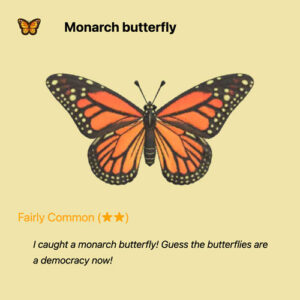
- Where to find it: Flying near flowers.
- When to find it: From 4 AM to 5 PM, except when it rains. For the northern hemisphere islands, in September, October, and November. For the southern hemisphere islands, in March, April, and May.
Emperor butterfly
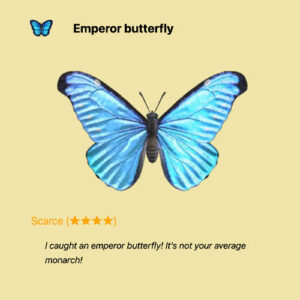
- Where to find it: Flying near flowers.
- When to find it: From 5 PM to 8 AM, except when it rains. For the northern hemisphere islands, in January, February, March, June, July, August, and December. For the southern hemisphere islands, in January, February, March, October, November, and December.
Agrias butterfly
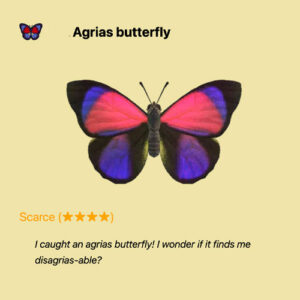
- Where to find it: Flying near flowers.
- When to find it: From 8 AM to 5 PM, except when it rains. For the northern hemisphere islands, in April, May, June, July, August, and September. For the southern hemisphere islands, in January, February, March, October, November, and December.
Rajah Brooke’s Birdwing
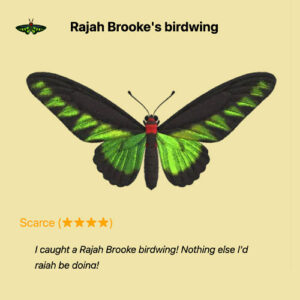
- Where to find it: Flying near flowers.
- When to find it: From 8 AM to 5 PM, except when it rains. For the northern hemisphere islands, in January, February, April, May, June, July, August, September, and December. For the southern hemisphere islands, in January, February, March, June, July, August, October, November, and December.
Queen Alexandra’s Birdwing
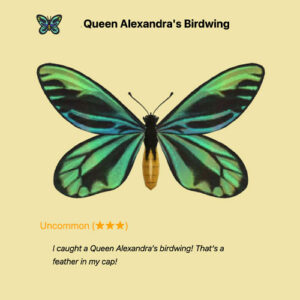
- Where to find it: Flying near flowers.
- When to find it: From 8 AM to 4 PM, except when it rains. For the northern hemisphere islands, in May, June, July, August, and September. For the southern hemisphere islands, in January, February, March, November, and December.
Moth
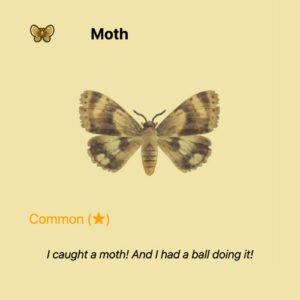
- Where to find it: Flying near light sources.
- When to find it: From 7 PM to 4 AM, except when it rains. All year for both hemispheres.
Atlas moth
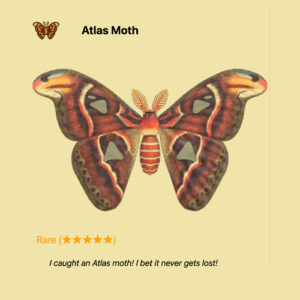
- Where to find it: It can be found on trees.
- When to find it: From 7 PM to 4 AM, even when it rains. For the northern hemisphere islands, in April, May, June, July, August, and September. For the southern hemisphere islands, in January, February, March, October, November, and December.
Madagascan Sunset Moth
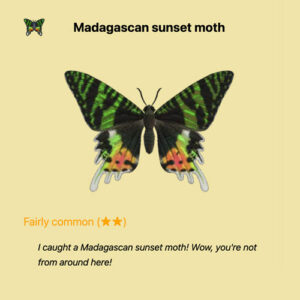
- Where to find it: Flying near flowers.
- When to find it: From 8 AM to 4 PM, except when it rains. For the northern hemisphere islands, in April, May, June, July, August, and September. For the southern hemisphere islands, in January, February, March, October, November, and December.
Long Locust
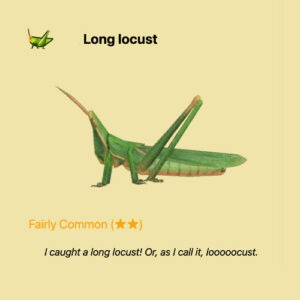
- Where to find it: On the ground.
- When to find it: From 8 AM to 7 PM, even when it rains. For the northern hemisphere islands, in April, May, June, July, August, September, October, and November. For the southern hemisphere islands, in January, February, March, April, May, October, November, and December.
Migratory Locust
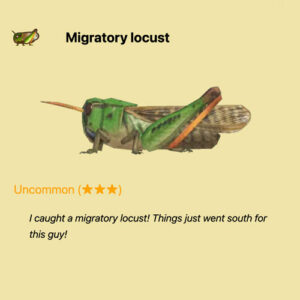
- Where to find it: On the ground.
- When to find it: From 8 AM to 7 PM, even when it rains. For the northern hemisphere islands, in August, September, October, and November. For the southern hemisphere islands, in February, March, April, and May.
Rice Grasshopper

- Where to find it: On the ground.
- When to find it: From 8 AM to 7 PM, even when it rains. For the northern hemisphere islands, in August, September, October, and November. For the southern hemisphere islands, in February, March, April, and May.
Grasshopper
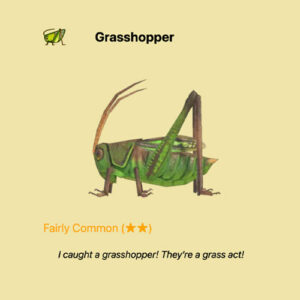
- Where to find it: On the ground.
- When to find it: From 8 AM to 5 PM, except when it rains. For the northern hemisphere islands, in June, August, and September. For the southern hemisphere islands, in January, February, and March.
Cricket
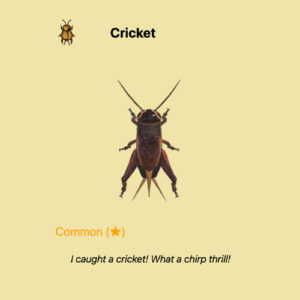
- Where to find it: On the ground.
- When to find it: From 5 PM to 8 AM, except when it rains. For the northern hemisphere islands, in September, October, and November. For the southern hemisphere islands, in March, April, and May.
Bell cricket
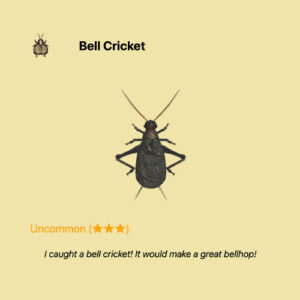
- Where to find it: On the ground.
- When to find it: From 5 PM to 8 AM, except when it rains. For the northern hemisphere islands, in September and October. For the southern hemisphere islands, in March and April.
Mantis
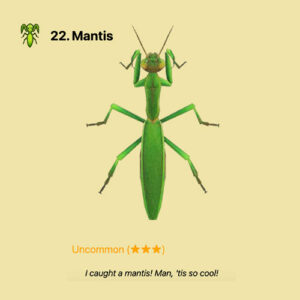
- Where to find it: On flowers.
- When to find it: From 8 AM to 5 PM, except when it rains. For the northern hemisphere islands, in March, April, May, June, July, August, September, October, and November. For the southern hemisphere islands, in March, April, May, September, October, November, and December.
Orchid Mantis
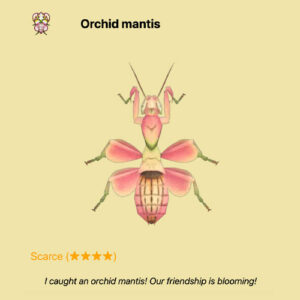
- Where to find it: On white flowers.
- When to find it: From 8 AM to 5 PM, except when it rains. For the northern hemisphere islands, in March, April, May, June, July, August, September, October, and November. For the southern hemisphere islands, in March, April, May, September, October, November, and December.
Honeybee
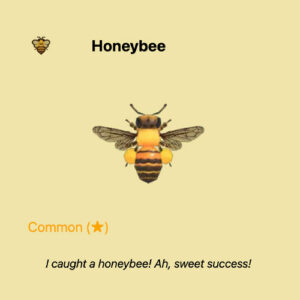
- Where to find it: Flying near flowers.
- When to find it: From 8 AM to 5 PM, except when it rains. For the northern hemisphere islands, in March, April, May, June, and July. For the southern hemisphere islands, in January, September, October, November, and December.
Wasp
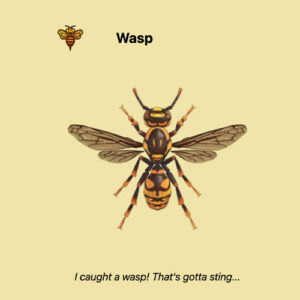
- Where to find it: Shaking non-fruit or cedar trees.
- When to find it: All day, even when it rains. All year for both hemispheres.
Brown cicada
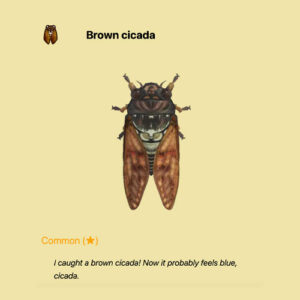
- Where to find it: It can be found on non-fruit or cedar trees.
- When to find it: From 8 AM to 5 PM, even when it rains. For the northern hemisphere islands, in July and August. For the southern hemisphere islands, in January and February.
Robust Cicada
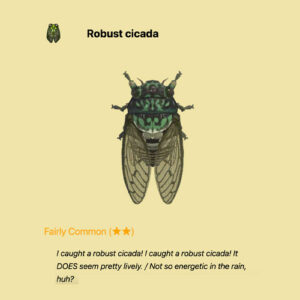
- Where to find it: It can be found on non-fruit or cedar trees.
- When to find it: From 8 AM to 5 PM, even when it rains. For the northern hemisphere islands, in July and August. For the southern hemisphere islands, in January and February.
Cicada shell
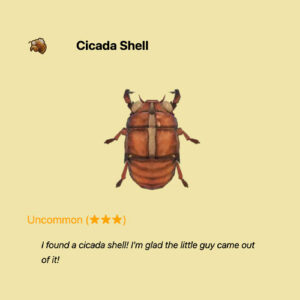
- Where to find it: It can be found on non-fruit or cedar trees.
- When to find it: All day, even when it rains. For the northern hemisphere islands, in July and August. For the southern hemisphere islands, in January and February.
Red Dragonfly
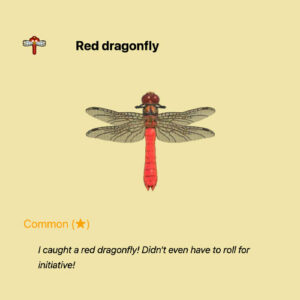
- Where to find it: Flying near water.
- When to find it: From 8 AM to 7 PM, except when it rains. For the northern hemisphere islands, in September and October. For the southern hemisphere islands, in March and April.
Mole Cricket
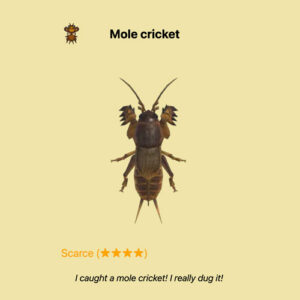
- Where to find it: Underground.
- When to find it: All day, even when it rains. For the northern hemisphere islands, in January, February, March, April, and May. For the southern hemisphere islands, in May, June, July, August, September, October, and November.
Ladybug
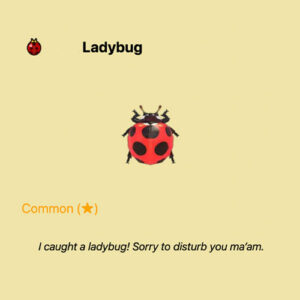
- Where to find it: On flowers.
- When to find it: From 8 AM to 5 PM, except when it rains. For the northern hemisphere islands, in March, April, May, June, and October. For the southern hemisphere islands, in April, September, October, November, and December.
Golden Stag
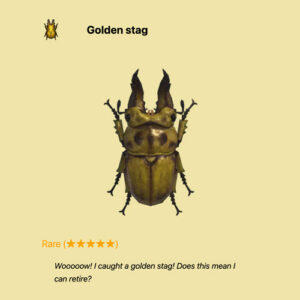
- Where to find it: On palm trees.
- When to find it: From 5 PM to 8 AM, even when it rains. For the northern hemisphere islands in June and August. For the southern hemisphere islands in January and February.
Rosalia Batesi Beetle
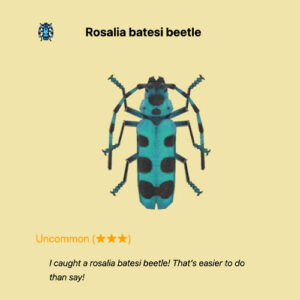
- Where to find it: On tree stumps.
- When to find it: All day, except when it rains. For the northern hemisphere islands, in May, June, August, and September. For the southern hemisphere islands, in January, February, March, November, and December.
Goliath Beetle
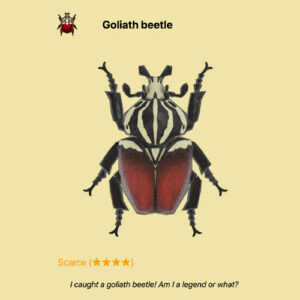
- Where to find it: On palm trees.
- When to find it: From 5 PM to 8 AM, even when it rains. For the northern hemisphere islands, in June, July, August, and September. For the southern hemisphere islands, in January, February, and March.
Walking Stick
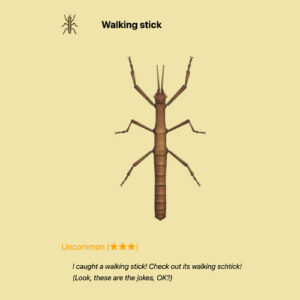
- Where to find it: On trees.
- When to find it: From 4 AM to 8 AM, then from 4 PM to 7 PM, even when it rains. For the northern hemisphere islands, in June, August, September, October, and November. For the southern hemisphere islands, in January, February, March, April, and May.
Flea
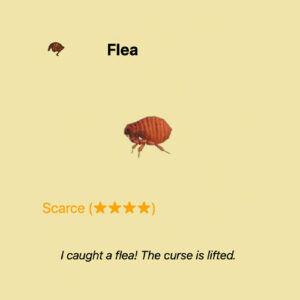
- Where to find it: On villagers.
- When to find it: All day, even when it rains. For the northern hemisphere islands, in April, May, June, August, September, October, and November. For the southern hemisphere islands, in January, February, March, April, May, October, November, and December.
Centipede
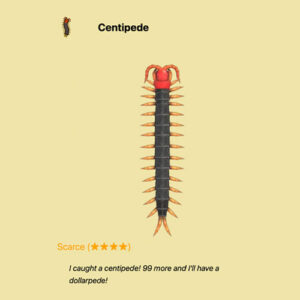
- Where to find it: From hitting rocks
- When to find it: From 4 PM to 11 PM, even when it rains. For the northern hemisphere islands, in January, February, March, April, May, June, September, October, November, and November. For the southern hemisphere islands, in March, April, May, June, July, August, September, October, and November.
Spider
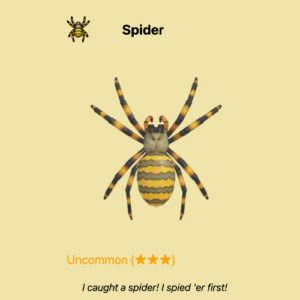
- Where to find it: Shaking trees.
- When to find it: From 7 PM to 8 AM, even when it rains. All year for both hemispheres.
Tarantula
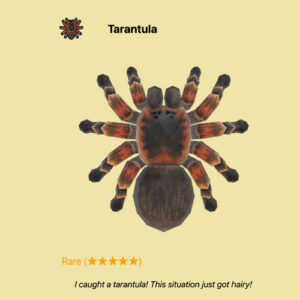
- Where to find it: On the ground
- When to find it: From 7 PM to 4 AM, even when it rains. For the northern hemisphere islands, in January, February, March, April, November, and December. For the southern hemisphere islands in May, June, July, August, September, and October.
- Be careful! It attacks.
Scorpion
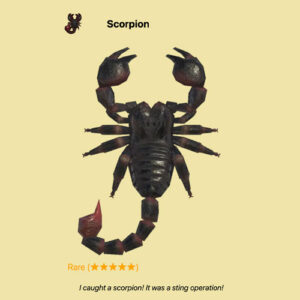
- Where to find it: On the ground
- When to find it: From 7 PM to 4 AM, even when it rains. For the northern hemisphere islands, in May, June, July, August, September, and October. For the southern hemisphere islands in January, February, March, April, November, and December.
- Be careful! It attacks.
What is the rarest insect in Animal Crossing?
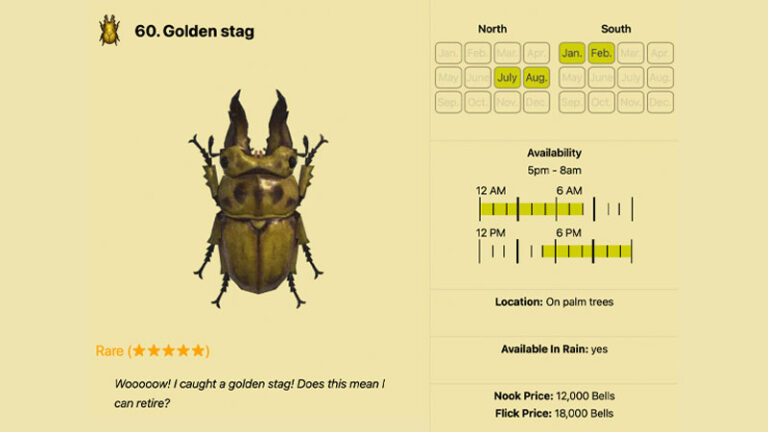
When it comes to rare insects in Animal Crossing: New Horizons, the Tarantula and Scorpion often come to mind. While their menacing appearance may initially seem intimidating, capturing these critters can be an exciting challenge. With a little strategy and patience, you’ll find they are easier to catch than they appear. So, don’t let their reputation scare you because the most elusive bug is the Golden Stag.
The rarest insect in Animal Crossing is definitely the Golden Stag. This bug can be found on palm trees from 5 PM to 8 AM. But it is like the Mew in Pokémon GO; it doesn’t always appear. It is a special bug, and you must wait patiently.
It is very challenging to spot, approach, and catch. That’s why it is the most expensive bug (you can sell it for 12,000 Bells).
To catch it, you should have your net ready and press button A before walking and getting closer carefully.
Did the Ugamians already catch all Animal Crossing bugs?
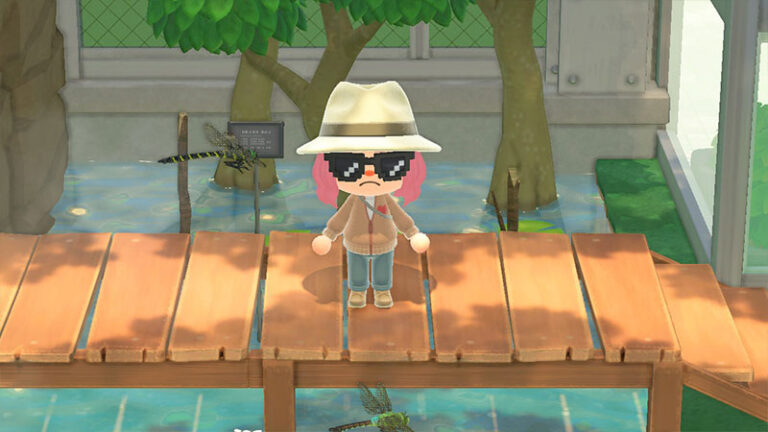
We have a confession to make. Our team may be experts in many things, but we’re still a work in progress when it comes to catching bugs in Animal Crossing.
Those elusive creatures like the Golden Stag, Tarantula, and Scorpion seem to have a personal vendetta against us. They’re like the stealthy ninjas of the insect world.
But don’t worry, Ugamers, we are working on that! We’re determined to conquer these tiny adversaries. So, we will update this article to give you the good news when we get all the ACNH bugs.
Are you ready to master the Insect Kingdom in Animal Crossing?

As you venture into the enchanting world of Animal Crossing: New Horizons, the diverse range of bugs awaits your discovery.
With the helpful information we’ve shared, you’re now equipped with the knowledge and techniques to catch these fascinating creatures.
But there’s so much more to explore! Dive into our website for more articles, tips, and tricks about the game. Get ready to immerse yourself in a world of bugs, creativity, and endless adventures!






